When software communicates with us, should they be friendly

In the 2013 Spike Jones film “She”, the mustache Joaquin Phoenix, who survived an unfortunate love, falls in love with his personal robot assistant named Samantha with all the passion.
The storyline might seem a little ridiculous and ridiculous to most of us, but the increase in the number of chat bots shows how much people want to talk to the machine as a person.
')
The purpose of Samantha, like any technology (especially bots), is to make the user's life easier. We wish not to press the buttons and keys on the site, but simply to pronounce the questions and immediately receive answers. And since science fiction is still fiction, it really allows at least very roughly to imagine how the world should work.
Faster is always better, and the conversation, as the structure of communication improves, the processing of natural language and bots with artificial intelligence, increasingly replaces keystrokes, becoming our preferred method of finding information.
At the last conference on software products and technologies from Microsoft (Build developers conference), CEO Satya Nadella announced: “Bots are new applications”; The same position is demonstrated by the actions of other technical giants, such as, for example, Facebook, who entered this sphere by releasing their bots for the Messenger Platform. Let's not forget about Telegram.
Even Slack introduces bots into your work environment to help with everything - from scheduling meetings to finding a new beautiful photo .
To see the booming development of bots, just look across the ocean, where bots have achieved tremendous success - in Asia, thanks to platforms such as WeChat and Kik, to which more than 650 million users come per month.
But really, is all this the future? Shut down our apps and sites and just talk?
And if we still do so, how should it all work?
We all need someone to talk to.
Chat bots are not new.
Back in 1966, MIT programmer Joseph Weizenbaum published the Eliza program, which analyzed the words entered into a computer, and then looked for an answer to them from the prepared list, simulating human communication.
Eliza was designed to simulate the work of a psychotherapist - clearly not to imitate a person at all. But Weizenbaum was concerned about what Eliza users saw.
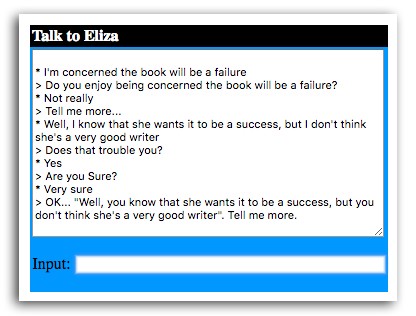
My communication with Eliza ...
Having the opportunity of free and open communication, users began to trust Eliza’s most intimate secrets.
In developing his “chat bot,” Weizenbaum’s intentions in no way involved creating a “friend” or some kind of “personality” with whom to maintain contact, he just wanted to make a useful utility. Well, like some kind of application. In fact, in his book Computer Power and Human Reason, he directly rejected the idea that computers could replace human intelligence .
According to Weizenbaum, then in the late 60s, the goal of that “chat bot” and all that technology, in reality, was only to simply create another tool that expands the user's intellectual capabilities.
And, despite the science fiction-supplied utopian vision of the future, filled with thinking assistants with free will, most bots are currently just tools. Jared Newman writes in Fast Company magazine :
“The best approach to bots is to think of them as a new kind of interaction model. Just as mobile apps reduce the long menus of desktop software, chat bots direct users to a narrow set of interactions that are the same for different bots. ”
“Whether such an action is carried out by entering text, giving commands by voice or witty jokes is secondary.”
Like any good product of developing an interaction experience, a bot is designed to make interaction easier than it is now. It is designed to eliminate "friction" - i.e. interactions that prevent people from intuitively and easily reaching their goals, and remove any barriers that arise when using your product.
And for this there are serious reasons.
Recall that when Amazon introduced a one-click payment, its annual revenue increased by approx. at 2.4 billion dollars .
Or, as a Bilingual Child application, tripled its income when it offered the option “Buy All” instead of the user buying each “book” separately.
Bots are focused on providing results of this type for each interaction.
The business knows that people generally do not have the desire to download some instructions and study them in order to use some new application for reading news or ordering food. While each individual application has its own adaptation process and its own learning curve, with a chat bot it is not necessary to learn how to use it. If you are able to enter from the keyboard or speak, then you are able to immediately begin to interact with the bot.
Is individuality required for a utility program?
All of the above raises an interesting question: if the utility and ease of use are the goal, then to demand from the bots "friendliness"?
Dan Grover, the developer of WeChat, in his recent post on "why bots will not replace applications," explores how Microsoft imagines the work of bots, examining one of the most basic (and, beyond any doubt, the most important!) Tasks of humanity: ordering pizza .
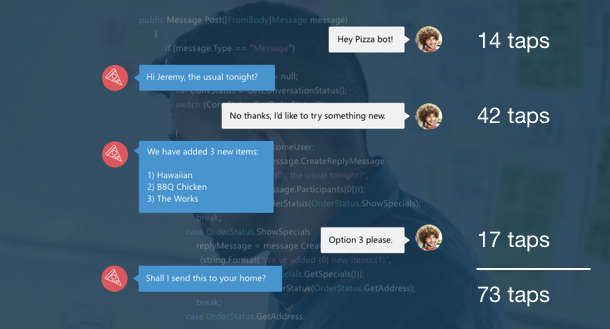
In the Microsoft version, our user communicates with the Pizza bot as if he were his friend. This bot knows the habits of its "friend". Knows where he lives. And, presumably, will withdraw money from it directly without the need to enter any payment information.
Utility - delete.
Individuality - maybe a little dried, but not much.
Dan then compares the above process with his experience of ordering pizza on the WeChat Pizza Hut:
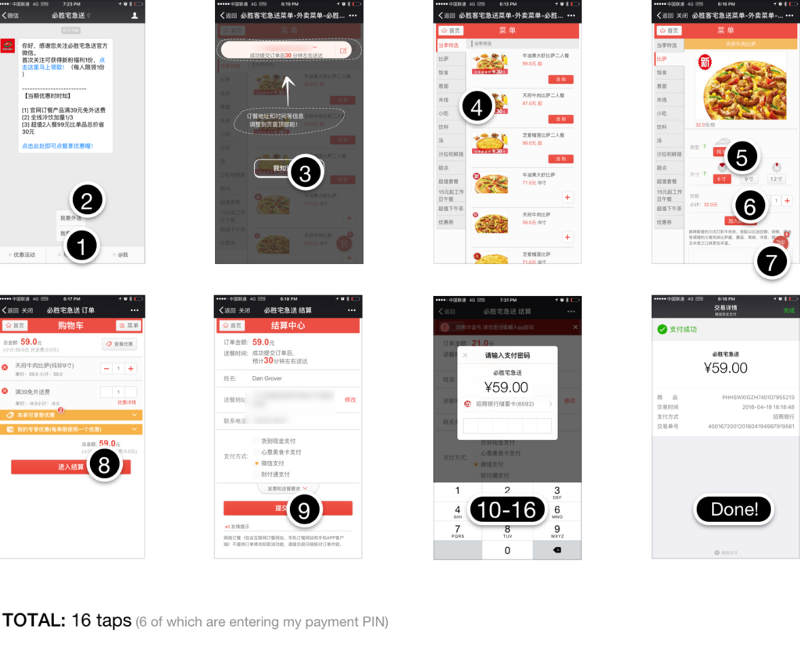
TOTAL: 16 clicks (6 of which are entering my PIN for payment)
Bot Pizza Hut is less like a friendly helper; rather, he is a qualified order taker who only gives you the opportunity to realize your desire — order pizza.
According to Dan, the difficulty of interaction can be characterized by the number of button presses - how many times do you need to press buttons on the screen to get the desired result?
If we assume this, then the discreet, impassive Pizza-Hat bot convincingly wins the friendly Pizza bot from Microsoft. The less clicks, the less difficulty. But does this necessarily mean improved interaction?
Dan believes that the “conversational” aspect of the design, implemented by Microsoft and other bot developers, is simply some form of ske-morphism , i.e. the decorative aspect of the design that was needed in the original product, but in the new product is functionally no longer required.
Skevomorphism, in principle, means an attempt to recreate in the digital space something from the world of analog devices or from the world of nature, even if this implies the reproduction of such constructions or characteristics that really take place in the world of nature but are not required in digital representation.
Recall that some of your applications, such as a calendar or contact list, have the same appearance as their physical counterparts:

Product developers believed that the user would be mentally unable to move to storing contacts on his phone or computer, if this is not similar to what he is already familiar with.
For bots, Dan argues, individuality is the same — elements of classical communication, such as refinement, greeting, chaffing, etc., are not required in “dialogue design”. If such elements create difficulties, then why will you use a bot, not an application? When the novelty passes, only the usefulness remains.
Look at the Siri. Of course, this virtual assistant knows how to let go of some jokes, but the ultimate goal is always utility.
Ask a question, get an answer. Everything!
Well, in the future there is no place for friendliness?
On the other hand, is the perspective of user interaction provided by a personal assistant, like Samantha, not what we all want? And since bots are not developed all the same, as devices with artificial intelligence "all-rounder", the prospect of a more natural interaction seems attractive.
Since most bots operate in an environment in which we interact with other people — for example, Messenger, Slack, and other chat services, we cannot but project human values onto them. Therefore, why not give them individuality?
But, as noted by Emmett Connolly, director of product development at Intercom, the presence of individuality does not imply the right to claim to be human :
“Don't knock down your own users (or, otherwise, don't be fooled by them). This means - do not use the indicators "is typing on the keyboard" or artificial delays to make the bot seem more like a person. On the contrary, bot messages should have a special style and be clearly marked, indicating that they are not generated by humans. But this does not exclude the provision of a personality to the bot. ”
Individuality has its goals beyond the simple "act as a person."
Sebastian Krumhausen, developer of Sure (a Facebook Messenger bot focused on helping to find offers to support sustainable business), suggests that individuality helps, in general, to improve user experience.
“The personality of a bot does not improve the interaction from the standpoint of efficiency or ease of use, but it makes this interaction more enjoyable. If the bot has a personality, then users are more tolerant of the situation in some kind of failure. "
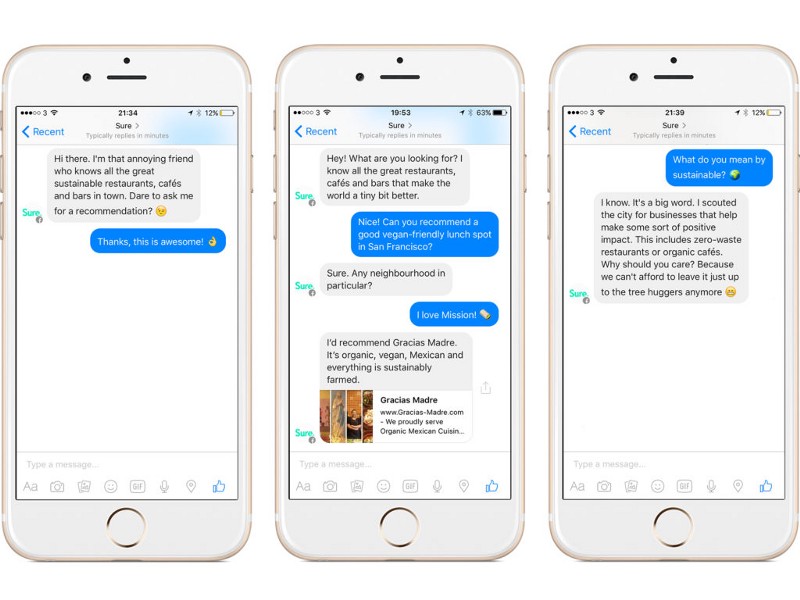
Instead of acting entirely on scripts (scripts), the Sure bot uses what is called “AI (artificial intelligence) with human participation”: team members can smoothly enter into communication if a question arises that does not fit into the framework of the bot's current functionality.
Therefore, when designing a personality for a bot, the developers supposedly lay down their own character traits - friendliness, wit, good nature, calmness. All these qualities soften the situation if you do not immediately receive the required response.
“Initially, people turned to us rather rudely, especially when the work was not going well,” explains Krumhausen. “However, when we added a bit of quirkiness to the reactions, people became more open and more friendly.”
Marketing experts call this phenomenon “brand anthropomorphism,” and companies have long used this method.
As Tyler Cowen explains to The New Yorker , decades before the Sure bots showed us their weird personality to interact, the Scrubbing Bubbles from Dow Chemical told consumers how “we do all the work, so you don’t have to do her ”, a cartoon music group California Raisins sang :“ I heard rumors ... ”, and the drawn baker of the Pillsbury company, giggling, told about cookies, rolls and buns.
“Corporations create such images for a simple reason: they know that consumers respond better to products that consumers seem to interact with on a personal level.”
With bots, however, communication is two-way. This means that the bot does not just create a personal connection with the brand, but is responsible for the maintenance and, as Krumhausen explains, for making the interaction.
“Just as in the situation when you create a product, it’s very important that it should be extremely focused from the very beginning. Therefore, communication is indeed the center of attention. We found it important that the bot to a certain extent nudges or leads communication in the direction we desire. ”
An almost perfect example of this is the new Quartz app.
Just like Sure, this application uses a combination of scripts (scripts) and written human interventions. The stories and content are written entirely by Quartz journalists in the style and tone of their bot and the voice of their brand.
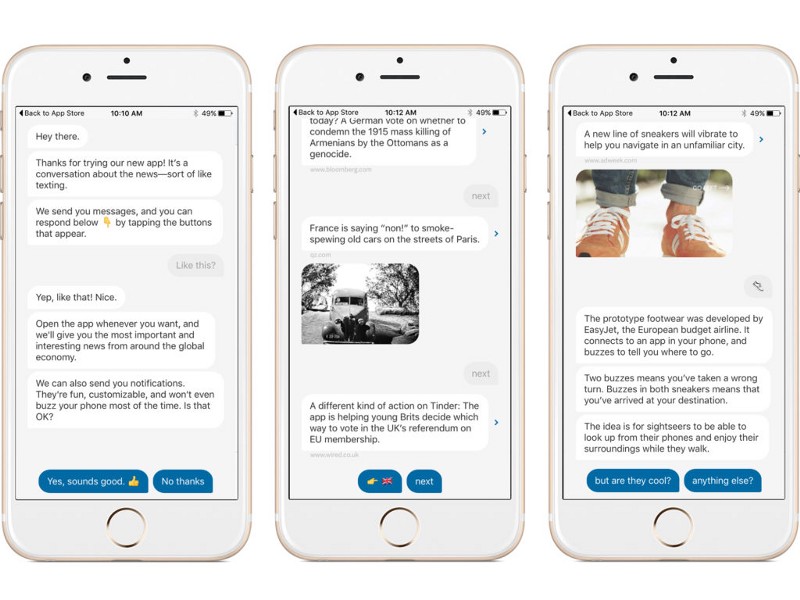
There is Quartz's intrinsic whimsy with a lot of emoticons, jokes and lightweight “trash” elements, but the “choose yourself” route is decidedly an aspect of interaction, offering only two possibilities for each storyline: read further or move on.
As Jared Newman notes in his article in the Fast Company magazine, there’s not the kind of interaction that a computer provides; There are still scripts here. Our answers are also.
The risk of giving the bot individuality
The Quartz app, being one of the best examples of combining utility and personality in a bot, also shows some unusual problems.
Here, just as sometimes in a situation where you have to communicate with someone at a party, there is no guarantee that you will like the person with whom you entered into a conversation. And even though most bot developers are trying to create an unusual and funny conversationalist who is easy to get along with - he can get bored quickly.
In the Quartz app, his reaction sometimes seems to be strained, similar to the distillation of an important news story in a version that your friend who is chilling with a can of beer would tell you and which, in fact, does not really correspond to the event itself.
Perhaps this is more of an episode in which Emmett Connolly called not to "fool" your users.
Individuality is, of course, wonderful, but all the time we know that we are not talking to another person. They do not know us. They can not be considered social signs. The ingenuous use of emoticons is just another form of indicators that “typing on the keyboard goes” when “humanizing” communication.
Also, as a longtime subscriber to the Quartz daily newsletter, I found this application more attractive than just scrolling through just another list of articles. But, since it is a standalone application, rather than a bot in Messenger, I wondered if I would enter this application to ensure its preservation (the self-storage and opening of an offline application may simply be too difficult for me).
And it is here that the “underwater stone” is hidden, as Krumhausen explains in relation to Sure:
“It is important that it is effective and that people get the expected prompt response right away. Like any other online user interaction, it should be fast and efficient. And if the result is no better or faster than with the existing interaction - in our case, something like Google Maps or Yelp, then people will not use the product in question. ”
Further, such a quick response means finding the person already in the right environment. The process of downloading an application and the steps to open it (rather than just reading email messages in an environment I often find) present more difficulties than the result deserves.
Leaving aside the arguments on individuality - will bots be fixed instead of applications?
All of the above boils down to the main question in relation to bots: will they replace the applications we know today?
For most, the answer is no!
Bots - whether they are a friendly, talkative "friend", or a clean utility - are just part of the technical ecosystem. They make it possible to reduce difficulties in key locations of your product, be it support, offers or sales.
And in the end , what they do may be more important than what they say.
Source: https://habr.com/ru/post/303566/
All Articles